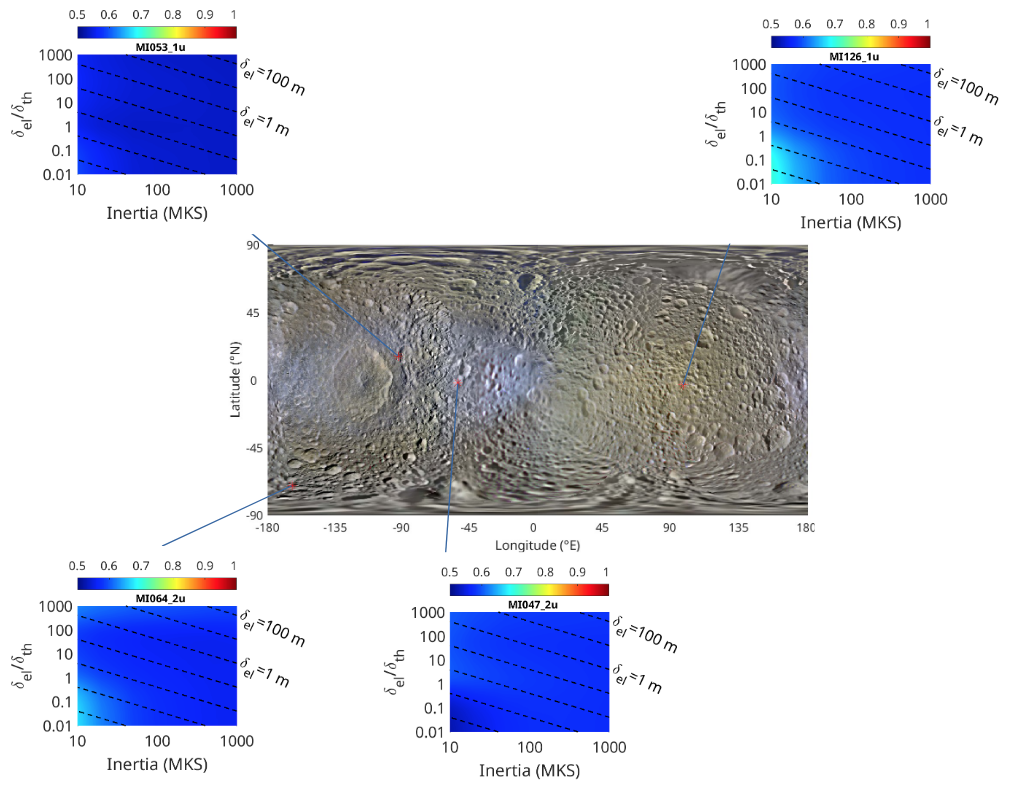Microwaving Saturn's airless icy moons Mimas, Enceladus, Tethys, Dione, Rhea, Iapetus and Phoebe
- 1LATMOS - UVSQ, Guyancourt, France (alice.legall@latmos.ipsl.fr)
- 2Institut Universitaire de France (IUF), France
- 3Cornell University, Ithaca, USA
- 4IPGP, France
- 5LESIA, Observatoire de Paris-Meudon, France
- 6JPL-Caltech, NASA, USA
The Cassini mission explored Saturn’s system from 2004 to 2017. On its board, a RADAR operating at a wavelength of 2.2 cm (13.78 GHz), had been initially designed for the exploration of the surface of Titan but also regularly turned its antenna towards the main airless icy satellites of Saturn (Elachi et al., 2004). In addition to its active mode, the Cassini RADAR included a passive (or radiometry) mode designed to record the thermal emission from the targeted surfaces at 2.2-cm. The scientific objectives of Cassini RADAR icy satellite observations were to provide constraints on the thermal, physical and compositional properties of the first few meters below the surface of the investigated objects. Doing so, it brings insights into the degree of purity and maturity of their water-ice regolith which are both indicative of their geological activity and interaction with their environment.
The RADAR dataset acquired on icy moons has already proved to be very fruitful bringing light to notable differences among Saturn’s mid-sized satellites (Ostro et al., 2006; 2010; Le Gall et al., 2019). However, it has not been fully analyzed yet. Following the final analysis of Cassini RADAR active observations of Saturn’s icy moons described in Le Gall et al. (2019) and expanding and improving upon the work of Ostro et al. (2006; 2010), we here present the analysis of all Cassini distant passive RADAR observations of these objects. This represents a total of 63 observations collected during 4 flybys of Mimas, 10 of Enceladus, 3 of Tethys, 6 of Dione, 9 of Rhea, 3 of Iapetus, 1 of Phoebe.
Most of Cassini RADAR icy satellite observations were distant i.e., occurred at ranges where the antenna beamwidth is comparable to or greater than the apparent angular extent of the target’s disk and were thus primarily designed to provide disk-integrated quantities: hemispheric-averaged radar albedos in the RADAR active mode and disk-integrated brightness temperatures in the passive mode. We here present the reduction of all available Cassini passive radiometry data with the goal of providing a range of possible values for the disk-averaged 2.2-cm emissivity of Saturn’s main airless satellites (separating their leading and trailing sides if relevant). These latter are obtained as a function of their possible thermal and electrical properties using a combined thermal and radiative transfer model (Le Gall et al., 2012; Bonnefoy et al., 2020). As an example, Fig. 1 displays the emissivity values obtained for Mimas from 4 distant radiometry observations. These values are shown as a function the assumed thermal inertia and ratio of electrical and thermal skin depths of Mimas’s near-surface. For all sets of parameters they are very low, as low as 0.5. For comparison, the disk 2.2-cm emissivity of Iapetus (Le Gall et al., 2014), Phoebe and Titan (see Sultana et al., this conference) is close to 0.9. Mimas low emissivity is indicative of subsurface mostly made of pure water ice and where volume scattering is very efficient maybe due to a highly fractured structure. We find that Enceladus and Tethys also exhibit low emissive surfaces and that, as a general rule, moon-to-moon and hemispheric emissivity variations seems to reflect variations in the moon interaction with Saturn’s dust rings, namely the E-ring for Enceladus and its neighbours and Phoebe’s ring further away from Saturn (Iapetus and Phoebe).
The derived emissivities will be analysed in light of the (active) radar albedos measured on the same hemispheres. Both active and passive microwave observations will be compared to several combined emissivity-backscatter models thus providing further clues on the physical properties of the icy moons. Their implications in terms of surface geology and evolution will be discussed.

Fig. 1: 2.2-cm emissivity of Mimas’s surface derived from Cassini distant radiometry observations and a combined thermal and radiative transfer model as a function of Mimas subsurface thermal and electrical properties (namely its thermal inertia and the ratio of its electrical and thermal skin depths). The sub-spacecraft point of each distant observation is indicated on an ISS map of the satellite.
How to cite: Le Gall, A., Sultana, R., Bonnefoy, L., Leyrat, C., and Janssen, M. A.: Microwaving Saturn's airless icy moons Mimas, Enceladus, Tethys, Dione, Rhea, Iapetus and Phoebe, Europlanet Science Congress 2022, Granada, Spain, 18–23 Sep 2022, EPSC2022-607, https://doi.org/10.5194/epsc2022-607, 2022.

